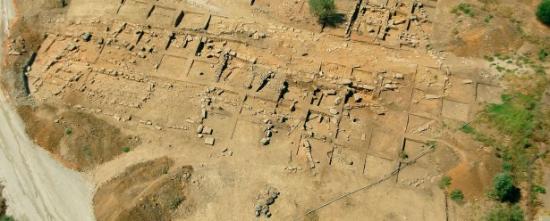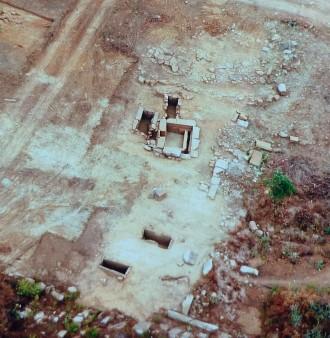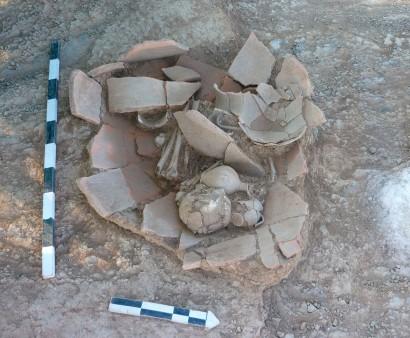PART.2
Kalydon and its wider area

Fig. 5. The general view of the excavation in the Calydona district
The third large excavation, which was carried out on the first section of the Ionia road, Antirrio-Kefalovrysso, was in the area of the Aetolian city of Kalydon, a town of particular importance located on the Aetolian coast, which had known great prosperity due to its favorable geographical position. Obviously outside the city’s walls smaller settlements belonging to the town had grown. One of these settlements has been investigated at the “Hondreika” locality, near the tunnel of Kalydon, which has already been constructed. Work on it started in 2009 and was completed in 2011.
The site is near the modern village of Aghios Georgios by Evinohorio, on the road to Messolongi, to the right of the old National Road, and extends on the slopes of a low hill northeast of the Kalydon’s fortification wall, at a distance of about 1 km from the main east gate of the town. Parts of the city’s fortification wall are visible from the excavation site. That side of the wider archaeological site is next to the Evinos valley, and it seems that since antiquity and until now this region has been of vital interest as an arable land area. The excavated area was agricultural land, mainly planted with olive trees.
The excavation has covered a total area of about 20.000 sq. m on several levels; the borders between them were marked by terrace walls of later dates. The extensive archaeological remains cover several periods of time, from Geometric and Hellenistic up to late Roman and post- Byzantine times. The foundations of the buildings rest on the natural sandstone soil of the area (flysch), which also forms the main building material of the monuments that have been unearthed. In the years 2009 and 2010 work has been carried out in all the sections into which the area had been divided, bringing to light mainly buildings and a bath complex (note 9).
The finds in the total area of the excavation also consisted of several supporting walls, a part of the Hellenistic and Late Roman cemetery, a building complex with a bath of the late Roman period, consisting of at least five rooms, of cisterns, a three-aisled basilica and a large Christian cemetery (note 10). Seven buildings in total have been investigated, constructed of large stone ashlars; they have supplied a large number of Hellenistic pottery vessels. Part of an ancient road also came to light; it went from NW to SE and it was dug into the natural rock, bearing signs of later phases. The interesting point is that the ancient road has been discovered to be right under the present rural road which had been used by the inhabitants until recently, before the Ionia road works had started.
The state of preservation of the ancient remains is not particularly good, as most of them have been kept on the level of their foundations (fig. 6).

Fig. 6. Habitation remainders in the Calydona district.
Moreover their fragmentary condition does not allow us to define the exact use of the buildings, at least for the time being and until the study of the material recollected has been completed. However, from a preliminary examination of the material and the excavation data it can be concluded that the cores of most of the buildings belong to the Hellenistic period, while some of them had been used until the Late Roman and Byzantine years, having undergone several alterations, repairs and extensions.
The cemetery investigated next to the settlement included several tombs of various periods, dating to the Geometric and the Hellenistic periods and up to the Christian era. The tombs have been located at about the same level, at a relatively shallow depth beneath the surface of the ground. Among them of special importance is a large tomb of Macedonian type dated to the Hellenistic times. It was discovered in 2009, while supplementary research was carried out in the year 2011 (note 11). It is built with large, rectangular, chiselled sandstone in the pseudo-isodomic trapezoid system; it has been preserved up to three stone high. The entrance door in the middle of the northwestern long side was sealed by a slab of sandstone. The tomb had been looted in the past. However it rendered a large number of finds, while during recent research in the room of the funeral beds some vases and a golden coin have additionnaly been found.
Around it, nearly touching it, several tombs dated to the Christian and Hellenistic times have been discovered (fig.7).

Fig. 7. View of section of cemetery in the Calydona district.
The latter are two cist graves with their four sides covered with vertically placed slabs, one on each side, without however covering slabs. Plaster remains have been located in both tombs, while the long sides of one of them were entirely covered with plaster. The tombs had been robbed and their contents were found to be disturbed, the result being that only a few bones and finds were discovered scattered around them. Underneath one of them the skeleton of a dog lying on its side was found. In the interior of the tomb the finds consisted of a few bones, sherds from a variety of vases with signs of burning, one loomweight but also part of the body of a clay figurine.
At a short distance, two children’s tombs, a cist grave and a pithos grave, dated to the Geometric period have been discovered, having a different orientation than the remaining tombs (northeast to southwest) (note 12). The cist grave contained a child burial, with the deceased’s body lying on its side in a contracted position and accompanied by several burial offerings. A golden hair ornament stands out among them. As regards the pithos burial (fig. 8), a child’s skeleton was also discovered, lying on its side in a contracted position; the finds collected include six vases, a bronze ring and a bronze nail. Next to these tombs several tombs dated to the Christian era have been found.

Fig. 8. Burial jar from the cemetery in the Calydona district.
In general the finds derived from the cemetery are quite numerous and of interest. In addition to the pottery vases (amphorae, unguentaria, lamps etc.), two small lead pyxides and also a variety of smaller finds, like bronze, silver coins and one golden coin, bronze rings, iron scraper, bronze and iron nails (possibly coming from a coffin), part of a figurine were also found.
It is clear that within the framework of the large public works carried out in Aetolia-Akarnania, a huge excavation operation is taking place. Movable and immovable monuments keep coming to light, making the archaeological map of the country richer.
Notes
-
The construction of this section, 35 km long, which is now open to traffic, resulted in the discovery of important archaeological sites. Rescue excavations were carried out in four different sites, under the supervision of Mrs M. Stavropoulou-Gatsi. For a preliminary presentation of the above, see Stavropoulou-Gatsi 2007. Of particular interest was the excavation in Kouvaras, where a Mycenaean cist grave belonging to the later Mycenaean years was investigated. It was the grave of a warrior yielding important and precious finds such as a gold kylix, two bronze swords, a bronze spearhead, two bronze greaves, a bronze caldron and pottery.
-
For a descρiption of the course of the ancient road see Alexandropoulou 1993, p.46 ff.
-
Research into this section is being supervised by archaeologist Mrs. F. Saranti, who will also publish the final results of the excavation. A preliminary report of the research and its results was presented at the 4th AETHSE in Volos, see Saranti 2012 (forthcoming).
-
On ancient Makyneia see for example: Woodhouse 1897, pp. 326-331, Lerat 1952, Kolonas 1993.
-
Hoepfner, Schwandner 1994, Hoepfner 1999 (with some parallels in Orraon, Kassope, Komboti- ancient Torybeia and Kallion).
-
Υoung 1956, Jones 1973.
-
On these farmhouses see Stavropoulou-Gatsi-Saranti 2010 2010 (forthcoming), also Saranti 2010β (forthcoming).
-
On the settlement investigated in the years 2002-2004 and 2006, see Saranti 2004 and Saranti 2010α.
-
In the years 2009-2010 excavation was being carried out under the direction of Mrs Stavropoulou- Gatsi who was then in charge of the Ephotare and who will publish the results. Since the end of 2010 the undersigned has taken charge of the excavation. We note that in the course of the dig, work was also carried out on areas other than the main location of the excavation (namely the Kalydon tunnel), where burial remains and a ceramic kiln were investigated.
-
Αfter tracing the Christian remains, the 22nd Ephorate of Byzantine Antiquities was notified as being competent and now has been in charge of the research since 2010.
-
For a first presentation of the remains of the settlement and of the tomb, see Stavropoulou-Gatsi 2012 (forthcoming), where there is reference to the exceptionally important funeral offerings in the tomb, which apart from interesting pottery vases also included gold, silver, bronze and iron finds, coins and other objects. From the skeletal remains only two skulls had been preserved.
-
Stavropoulou-Gatsi 2011, with a list of the sites in the wider area of Kalydon, where cist and pithoi graves dated to the Geometric period have been found.